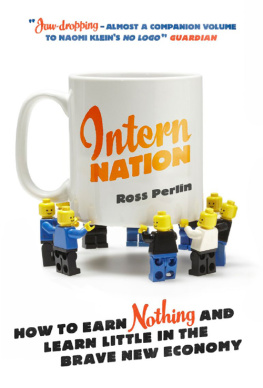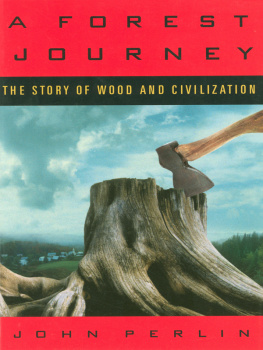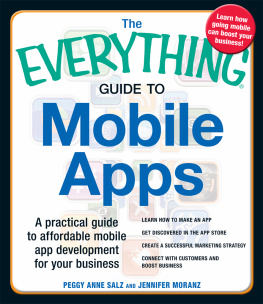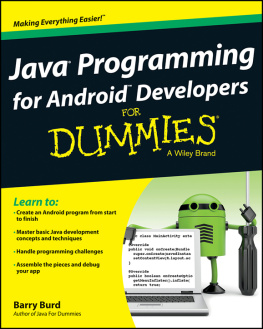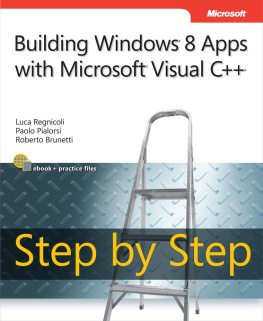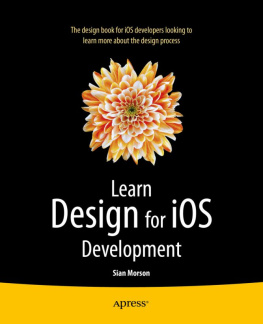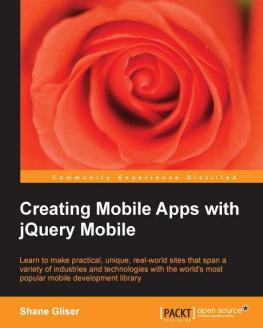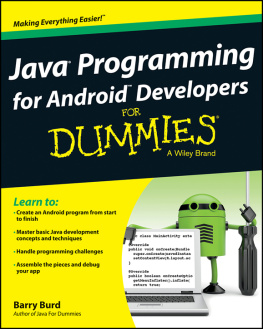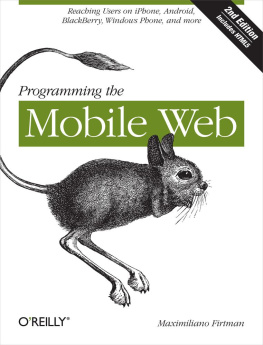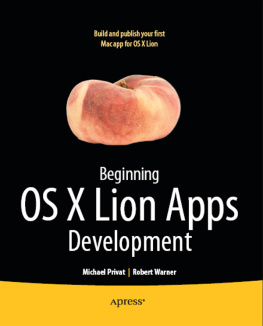Table of Contents
Dedication
Thanks to ViziApps co-founders George Adams and Michael Kuperstein for creating one slick app authoring tool and giving me the opportunity to jump into the deep end of app development.
Thanks to David Asher of ViziApps for the advice and support in writing this book and helping pull me out of the deep end on occasion.
Thanks to Dan Kalagher, Ann Hewitt, and Shyam Svai for the help and suggestions (and to Dan for not laughing at me when I made the email client error).
And as always, thanks to Connie for having the courage to come along with me as I jumped not just into a new tool but a whole new market (and a whole new world of technobabble).
Introduction
Welcome to this book on how to create mobile apps without needing a programmer. If you've wanted to create an app for your company or organization but haven't been able to justify spending tens of thousands of dollars and weeks or months of time, this book is for you.
The purpose of this book is to explain how to create a custom business app quickly, inexpensively, and in a way that's responsive to user feedback or changing business conditions.
The obvious question is, why bother when thousands of apps are available today in the App Store and Play Store? One of them should meet your needs. Do you need to create another app?
The answer may be no. You may find the right app in one of the stores. Download it and you're good to go.
But you may not find the right app. None of the many apps that you find may be quite right. If only that app could be modified to do this.. . A few years ago, that would have been impossible without a programmer.
Today, however, business users, not programmers , can create powerful apps without ever seeing code. You're not going to build the next Angry Birds tm . And even if you don't have to work in code, you do have to be sure the app does what you need, is easy to use, and attractive, (and meeting those requirements can take a lot of work).
Nevertheless, you can create custom apps that meet your needs and do so quickly and inexpensively - in days, not weeks or months. This book will show you how.
This book has two goals that you'll see reflected in its structure. It provides an overview of mobile concepts and terminology, not comprehensively but enough to lead into the second goal, introducing you to a class of app development tools called DIY (Do It Yourself) tools and to actually use one of them, ViziApps Studio, to create an actual app as a demonstration and to get you going on your own app.
Why ViziApps? In the interests of full disclosure, I'm an independent consultant who's been associated with the company almost since its founding. I'm a certified ViziApps developer, created the training materials for the company, and do app development and periodic pre-sales and technical support for people considering using the tool.
The focus on ViziApps isn't to deny the existence of competing tools, some of which I'll mention or refer to in the course of the book. I just consider ViziApps to be one of the most flexible and powerful tools in the DIY category.
Structure of This Book
Chapter 1 introduces the whole concept of "mobile" - what it is, types of mobile that you can create, and business justifications for creating an app. All written in non-technical language with minimal jargon. If you just want to learn about mobile, you can stop here. But that's not why you bought this book...
Chapter 2 introduces ViziApps Studio, the DIY tool you'll use to create the practice app and real apps if you so desire.
Chapter 3 covers app design - making sure your app is attractive and effective as well as works programmatically.
In chapters 4-8, you'll learn about ViziApps-specific features and follow exercise instructions to create a type of app called a hybrid that can run on iPhones, Android phones, iPads, and tablets. It's a simple app - a lead tracker that you'd use at trade shows to keep track of prospective customers - but a real app nevertheless.
Chapter 4 describes ViziApps' page design features that you can use to create your app's screens. In this chapter, you'll also find part 1 of the instructions for creating the sample app, laying out the screens.
Chapter 5 describes ViziApps' data handling options and focuses on one that can be used by any business user familiar with Excel or other spreadsheet. Not all apps have to handle data but if you want to create an app to do inventory counts or track leads at trade shows, for example, you'll have to work with data. In this chapter, you'll also find part 2 of the instructions for creating the sample app, creating the database.
Chapter 6 covers how to connect your ViziApps app's screens to data you need to make the app work. In this chapter, you'll also find part 3 of the instructions for creating the sample app, connecting app pages to the database to pass data back and forth between them.
Chapter 7 covers non-data ViziApps features in addition to those described in chapter 6 - how to send an email from your app, take a picture, add images, and more.
Chapter 8 describes the steps for getting your app in the App Store and Play Store in order to get it out to the world.
Chapters 4-8 dealt with hybrid apps. Chapter 9 looks at a different type of app called a web app. Web apps use many of the same features as hybrid apps but work differently and can eliminate some problems that can arise with typical hybrid apps.
If you're completely new to mobile, read the whole book in sequence. If you're familiar with mobile concepts and design and just want to dive right into ViziApps itself, start with chapter 4.
You won't be a programmer when you finish the book but you'll have a good understanding of the app world and you'll be able to create your own apps.
And if you enjoy technology and learning new things, it's fun.
The DIY Mobile Blog
ViziApps is cloud-based software which means it can change quickly and put the book out of date. To avoid this, check for updates at the DIY Mobile blog at http://diymobileblog.blogspot.com/. (To be notified of updates, follow me on Twitter - my handle is NeilEric.) Updates will periodically be incorporated into a new release of the actual book.
1 - Overview of Mobile
Three Common Questions
Im not a programmer. Can I do this?
Probably, depending on what you want your app to do. There are four main tasks in creating an app:
Decide what you want the app to do and mock it up, ideally on paper.
Create the app pages based on the mockup.
Create any required database and connect the app pages to the database in order to be able to pass data between the app and the database.
Get the app into either or both of Apple's App Store or Google's Play Store.
Step 1, planning, seems obvious at first, then can seem difficult until your equivalent experience kicks in. If this is your first app, you've probably never had to turn a vague idea for an app - "keep track of prospective clients we meet at trade shows" - into a formal set of tasks for the app, then turn those tasks into smoothly functioning and flowing screens and data. But planning and designing the app isn't that different from planning and designing a PowerPoint presentation or breaking an operation down into a series of tasks to explain it to a new hire. And you'll find that the DIY tools let you quickly create a prototype and quickly change it in response to feedback. (And you'll get better at it with your second and third apps.)
It may take you several tries before you get it right, which is why it may be a good idea to work on paper at this stage. You'll find a discussion about design and a paper app page template in chapter 3.
You don't have to be a programmer to do planning, but you do need to understand the process or task that will be the subject of your app.
Next page


